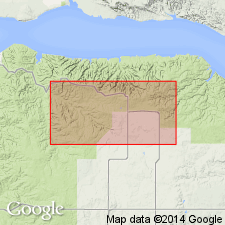
- Usage in publication:
-
- Missouri Breaks Formation
- Modifications:
-
- Named
- Dominant lithology:
-
- Sandstone
- Limestone
- AAPG geologic province:
-
- Williston basin
Summary:
Named as a subsurface formation (1 of 8) of Interlake Group. Type section is the interval from 11,778 ft to 11,805 ft--or 27 ft--in the Texaco Inc. #1 Missouri Breaks well in SWSE sec 10, T153N, R96W, McKenzie Co, ND in the Williston basin. Overlies Mendenhall Formation (new) of Interlake. Underlies Sherven Formation (new) of Interlake. Is characterized by tight silica-cemented quartz sandstone or a series of sandstone stringers interlaminated with and gradational into nearly black at base upwards into red laminated limestone. Considered to be an anoxic lacustrine unit. Fish fragments and ostracods abundant. Pyrite disseminated throughout the black limestones. Upper part may include marsh and fluviatile facies. Silurian age. History of stratigraphic nomenclature chart. Assigned to the upper part of the "upper Interlake beds" by some of the earlier workers.
Source: GNU records (USGS DDS-6; Denver GNULEX).
For more information, please contact Nancy Stamm, Geologic Names Committee Secretary.
Asterisk (*) indicates published by U.S. Geological Survey authors.
"No current usage" (†) implies that a name has been abandoned or has fallen into disuse. Former usage and, if known, replacement name given in parentheses ( ).
Slash (/) indicates name conflicts with nomenclatural guidelines (CSN, 1933; ACSN, 1961, 1970; NACSN, 1983, 2005, 2021). May be explained within brackets ([ ]).

